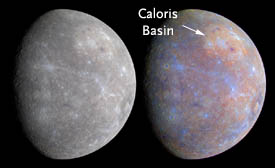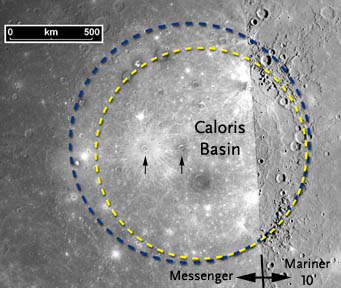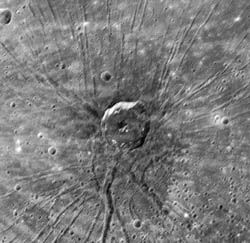The Space Age was barely two years old when, in October 1959, the Soviet Union sent Luna 3 to photograph the far side of the Moon. Astronomers were ecstatic once they'd finally glimpsed the never-before-seen half of the lunar landscape. Luna 3's 40 crude images showed that the far side was different than the side facing Earth, with very few dark, basalt-filled maria.

Even when viewed in color (left), Mercury is essentially a black-and-white world. When its subtle color differences are exaggerated(right), fresher impacts appear "bluer" (less red) than the surrounding terrain. The lighter hues inside Caloris basin, 960 miles across, may hold clues to the planet's internal composition. Click on the image for a larger view.
NASA / JHU-APL / Carnegie Inst. of Washington
Planetary scientists have been likewise awaiting a chance to glimpse details on the half of Mercury that went unseen by Mariner 10 in the mid-1970s. And, thanks to Messenger's close flyby on January 14th, they've gotten a good start on filling in the blanks. They provided a few peeks at what the craft radioed to Earth during a press conference on January 30th.
Before I forget, let me note that the mission's actual name is Mercury Surface, Space Environment, Geochemistry, and Ranging — that's why everyone just calls it "Messenger."
But what's in a name? The spacecraft and all seven of its instruments really delivered. Before turning the spotlight over to the imaging specialists, principal investigator Sean Solomon noted that the planet's magnetic field — unique among planets in its similarity to Earth's — hasn't changed since Mariner 10's visit. But the sodium and hydrogen atoms found streaming away from Mercury (more so from the north half than from the south) will require more observations to puzzle out.

Carloris basin, one of the largest impacts in the solar system, was discovered by Mariner 10 during a series of flybys in 1974-75. But most of the basin was in shadow at the time. Messenger's view show that Caloris is actually 20% bigger (blue circle) than previously thought, about 960 miles across. Arrows point to a small, fresh crater and to the like-sized "spider" (seen in close-up below).
NASA / JHU-APL / Carnegie Inst. of Washington
Messenger's views are gorgeous, though they lack the color and variety seen most everywhere else in the solar system. To appreciate Mercury, ya gotta love craters — to the casual eye, that's all the pictures show. Big ones, little ones, splashy ones, dark ones, and a few double-ringed ones.
The biggest, baddest crater on Mercury — and the one most likely to reveal how this planet came to be — is Caloris basin. Mariner 10 saw only a slice of Caloris, but Messenger has now imaged all of it. At 960 miles (1,550 km) across, it's actually 20% bigger than previously thought.
Lots of curious features lie inside this Alaska-size saucer. One, nicknamed "the spider," is a 25-mile-wide crater with scores of fractures radiating away from it like bicycle spokes. It's the kind of pattern you'd get if something were pushing up on the crust from below.

This remarkable feature — nicknamed “the spider†by Messenger's science team — lies near the center of Caloris basin. A set of troughs radiates outward from a 25-mile-wide crater in a geometry unlike anything seen by Mariner 10. The troughs apparently resulted from the extension (breaking apart) of the basin's floor.
NASA / JHU-APL / Carnegie Inst. of Washington
The press conference was as interesting for what wasn't said as for what was. No one really commented on the surface composition, though I'm sure there's already plenty to say about it. And the team was mum on what they've learned about the planet's interior. (By flying by so closely, the spacecraft was yanked around by the planet's gravity in subtle yet revealing ways.)
Mercury's density is too high — there's too much iron inside it — for the planet simply to have assembled from the mix of compounds present near the Sun when the solar system formed. So planetary scientists think one of three things happened: (1) somehow Mercury came together with a paucity of lower-density silicates, the kind found abundantly in Earth's crust; (2) it endured a period of extreme heating from the young Sun, which caused many minerals to simply boil away; or (3) something really big collided with Mercury and stripped away the lion's share of its crust and mantle.
The compositional data returned by Messenger probably offer crucial clues to which of these scenarios is correct. But the Messenger scientists didn't address this subject during the press conference — and they'll have little more to say until mid-March, when they'll present a far more complete analysis at the annual Lunar & Planetary Science Conference in Houston, Texas. I'll be out in the audience, scribbling furiously.
 3
3
Comments
Karl Teppo
February 2, 2008 at 8:59 pm
The spider feature is indeed caused by outward pressure from within the inner core of Mercury, which in my theory is from a zero K neutron embryo core, a relic from a previos 'Eon Cycle' of the Universe. I feel sure of this because of the active magnetic field, also common to the Sun, where the faster spin of the neutron core creates a differential rotation. Top Down element evolution is contrary to the now accepted Bottom Up accretion theory. The missing matter belongs to the previos Eon Cycle whose remnants are still active, escpecially in the core of all bodies having a magnetic field! The theory of adhock sloshing molten iron flow cores can now be disgarded. The postulated 80% of the missing matter belonging to the cold Eon Cycle is now found, by accepting the Top Down era is a brief period for us in the Sun!
You must be logged in to post a comment.
Enrico the Great
February 7, 2008 at 6:03 pm
We have been waiting for these photos for years, fascinating, I cannot wait for more!
You must be logged in to post a comment.
anderson smith
July 27, 2008 at 12:57 am
A mercury mirror is a dish with a layer of mercury on it. The dish is rotating so that the mercury assumes a parabolic shape. A parabolic shape is precisely the shape that the primary mirror of a telescope must have. Compared to a solid glass mirror that must be cast and ground and polished, a rotating mercury mirror is much cheaper to manufacture.
______________________________________
anderson smith
Wide Circles
You must be logged in to post a comment.
You must be logged in to post a comment.